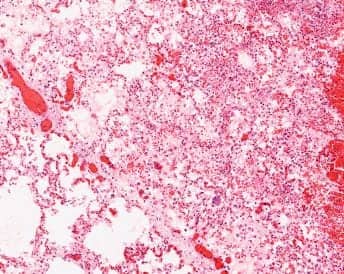
An Institute for Healthcare Improvement (IHI) initiative had been implemented as a Six Sigma Green Belt project at University of North Carolina Children’s Hospital to improve the quality and safety of care for critically ill pediatric patients. Through the efforts of pediatric intensive care unit (PICU) clinical leaders, frontline staff, and program management teams, we have made several improvements in eliminating hospital–acquired infections (HAIs), in communication systems, and in partnering with families. Recommendations from the IHI made it clear that our HAI numbers needed much improvement, and ventilator-associated pneumonia (VAP) was one of those infections targeted: In a 1-year period, there was a VAP rate of 2.6/1,000 ventilator days in the PICU.1
With the correct tools in hand, the team prevented infections every day for every patient, including a high number of surgical patients, multiple patients on mechanical ventilation with greater than 3 months’ length of stays, and other medically fragile patients. This included staying VAP-free during a very busy flu and virus season. Staff was asked to take ownership of the project to observe and give feedback in hand-hygiene observations and included the compliance data that were on a dashboard. Strategies were developed to better communicate about patient care. During that time period, the PICU saw a 65% reduction in VAP.1
The Six Sigma Approach
The effort to eliminate VAP in the PICU started in 2008 when a multidisciplinary Six Sigma Green Belt Team, including a physician, a nurse, and two respiratory therapists, completed a project resulting in a significant reduction of VAP cases in the PICU. The Six Sigma approach breaks down the process into different steps. The first step was to improve communication among the physicians, frontline staff, and families. This required the implementation of two evidence-based strategies. The daily goals communication sheet ensured that the entire care team understood the plan for the patient each day. This meant that staff and physicians had to sign off after goals for the patient had been discussed. The team also took a standardized approach to daily multidisciplinary rounds to make them more effective and efficient. This included allowing families to participate in their children’s care and attend rounds.
The second step was to cut down the length of time the team spent rounding. This helped to put the staff back at the bedside as opposed to spending half the day rounding. The PICU looked at several options, including the “sterile cockpit approach” and board rounds. During board rounds, there were to be no interruptions unless there was a patient who was at high risk or deteriorating. Board rounds gave staff information as to what was happening in the unit, transports, and procedures scheduled for the day and who was doing well and who was at high risk for failure. A second physician was added to meet the needs of the unit so that rounds could continue without interruption. With standardized rounds, everyone knew what to expect and when it was their turn to report. This had its challenges, especially for the respiratory therapists. In a 20-bed unit and two respiratory therapists covering, it was difficult for the therapists to remain in rounds when other patients had needs requiring their services. The respiratory therapists were given priority during rounds in order for them to meet the needs of other patients.
After an increased number of infections in early 2010, multidisciplinary team members identified areas of noncompliance and strategies to address them by incorporating a three-part, 90-day action plan:
- The PICU Nursing Education committee conducted education and simulation training for all PICU team members;
- Vendor representatives from different companies conducted continuing education on oral care products for nursing and respiratory team members; and
- Staff conducted regular hand-hygiene observations and ventilator care bundle audits, providing immediate feedback regarding compliance. Small rewards were offered to keep staff motivated to do audits and offer feedback.2
Standardized Care

Through implementation of the ventilator-associated pneumonia “bundle” from the IHI, the care received by all ventilated patients was standardized. This bundle consisted of the following preventive measures:
- Elevating the head of the bed (HOB) to 30 degrees when possible while the patient was requiring mechanical ventilation.
- Giving the patient daily “sedation vacations” or breaks from sedation, which allowed the medical team to assess the patient’s mental status. Coupled with the sedation vacation were spontaneous breathing assessments to determine the patient’s readiness to come off the ventilator. These were essential to decreasing the number of days a patient remained ventilated. Doing both the vacation and assessment at the same time gave the best predictor for weaning and ventilator liberation.
- Applying measures as needed to prevent peptic ulcer disease and deep vein thrombosis complications that prolong ventilation and increase the risk of developing ventilator-associated pneumonia.
- Providing oral care frequently and with a long-lasting antiseptic, which dramatically limited bacterial overgrowth in the oral pharynx of a ventilated patient.3
Real-time data was collected using the following techniques.
Hospital-acquired infection data collection and analysis. Patients whose condition met the National Healthcare Safety Network/CDC’s surveillance definition of VAP were determined by the hospital epidemiology department, with prevention of infection personnel reviewing all culture and electronic medical records of patients showing signs of ventilator-associated pneumonia. The Six Sigma team’s analysis of the preintervention VAP data found that the length of time a patient spent on the ventilator was positively associated with the risk of ventilator-associated pneumonia.
Process measures data collection and analysis. Blinded direct observations of care provided to ventilated patients were used to collect data about frequency/appropriateness of hand hygiene and frequency/appropriateness of specific actions related to ventilation (eg, mouth care, elevated HOB, sedation vacation). Inconsistencies in the delivery of standardized mouth care, elevation of HOB, and sedation vacation were identified. Focus groups of physicians, nurses, and respiratory therapists identified individual staff members’ lack of knowledge about caring for patients on ventilators and hand hygiene.
Improvement of Care
There were four interventions determined to be necessary to improve the care of ventilated patients:
- Mandatory education via attendance at the hospital-acquired infection prevention blitz. This provided education to nurses, doctors, and respiratory therapists about VAP-prevention bundle steps and appropriate hand hygiene.
- Mandatory skills demonstration at the hospital-acquired infection prevention blitz. Using a patient care simulation laboratory, physicians, nurses, and respiratory therapists demonstrated their knowledge of the VAP-prevention bundle steps and appropriate hand hygiene.
- Ongoing process measure feedback directly to PICU staff. This was accomplished via VAP bundle observations and feedback using a dashboard at the nursing station containing compliance data graphs.
- Ongoing outcome measure feedback directly to the PICU staff. This was done through “Days Since Last Infection” posters at the nursing station.
Assuring Buy-In
How did we get the staff to buy into the quality improvement measures? First, other levels of Six Sigma being brought in from the administrator’s side to support the interventions in our study were essential. The involvement of a senior administrator affirmed the importance of the project in general. In particular, it removed barriers such as delays in purchasing equipment and encouraged health care workers to urge even their colleagues of higher rank to use hand hygiene. It also produced a greater level of accountability and buy-in at all levels, which made it easier to change clinical cultures and practices.3 Second, without regular and repeated follow-up, people return to old habits. This required members overseeing quality-control measures to repeat some of the projects as a reminder to staff of how important it was to continue with hand hygiene and ventilator bundles.
Third, the success of the interventions and returns on the investment depended on staff members’ investment in the change. For example, the early observations, surveys, and focus groups in our study all demonstrated to staff members where improvements needed to be made. This fostered open discussions among staff members, which in turn produced clear guidelines and standards. In addition, when physicians and other personnel from outside the pediatric intensive care unit did not comply with hand hygiene and a staff member identified the problem, the attending physician in the unit would back the staff member up or initiate a dialogue with noncompliant colleagues and follow up as needed. The bedside staff members in the unit recognized the importance of these initiatives and understood that the unit’s physicians supported them in trying to achieve compliance.4
Conclusion
The results demonstrate that simple techniques like hand washing and raising the head of the bed quality improvements that target education and the process of delivering health care can significantly reduce HAIs and improve the health and economic outcomes of critically ill children. These are practical and low cost interventions that can reduce VAPs, which saves money5—and lives.
Sheila White, BS, RRT-NPS, is clinical manager, Women’s and Children’s Hospitals, and Co-ECMO coordinator, department of respiratory care, University of North Carolina Hospitals; Tina Adams, RN, is infection preventionist, University of North Carolina Health Care System, Women’s and Children’s Hospitals, Chapel Hill. For further information, contact [email protected].
References
- Improving Pediatric Critical Care Quarterly Report (2) FY 2011.October 1, 2010–December 31, 2010. Available at: tinyurl.com/PediatricCritCare. Accessed January 16, 2012.
- Tablan OC, Anderson LJ, Besser R, Bridges C, Hajjeh R. Guidelines for Preventing Health-Care-Associated Pneumonia 2003: Recommendations of CDC and the Healthcare Infection Control Practices Advisory Committee. MMWR Recomm Rep. 2004;53(RR3):1-36.
- UNC Children’s Hospital Improving Pediatric Critical Care Quarterly Report (4). FY 2011. April 2011–June 2011. Available at: [removed]www.med.unc.edu/cce/files/ipcc/IPCCFinalReport.pdf[/removed]. Accessed January 10, 2012.
- Harris B, Hanson C, Christy C, et al. Strict hand hygiene and other practices shortened stays and cut costs and mortality in a pediatric intensive care unit. Health Affairs. 2011;30(9):1752-8.
- Larson EL, Quiros D, Lin SX. Dissemination of the CDC’s Hand Hygiene Guideline and impact on infection rates. Am J Infect Control. 2007;35:666-75.









